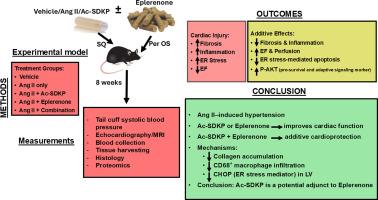Ac-SDKP和eperenone对C57BL/6J小鼠血管紧张素ii诱导的心脏损伤具有附加的心脏保护作用
IF 2.2
Journal of molecular and cellular cardiology plus
Pub Date : 2025-09-19
DOI:10.1016/j.jmccpl.2025.100485
引用次数: 0
摘要
依普利酮是一种矿物皮质激素受体拮抗剂,是一种抗高血压和心脏保护药物。我们发现n -乙酰- seryl -天冬氨酸-脯氨酸(Ac-SDKP)对心脏有有益作用。在血管紧张素II (Ang II)诱导的高血压中,Ac-SDKP与依普利酮联用是否能提供额外的心脏保护作用尚不清楚。雄性C57BL/6J小鼠分别给予假药、Ang II (2.9 mg/kg/day, s.c)、Ang II + Ac-SDKP (1.6 mg/kg/day, s.c)、Ang II + Eplerenone (150 mg/kg/day,小鼠饲料)或Ang II + Ac-SDKP + Eplerenone。治疗持续了8周。每周测量收缩压(SBP)。实验结束时进行超声心动图(Echo)和磁共振成像(MRI)检查。所有小鼠的收缩压均升高,且不受任何治疗的影响。angii治疗组后壁厚度(PWT)和左心室质量(LV)均增加。左室质量没有受到治疗的显著影响,但两种单一治疗均可减少PWT,并以Ac-SDKP和eperenone联合治疗的减少幅度最大。与假手术组相比,Ang II组的射血分数(EF)降低。EF随所有治疗(MRI)而增加,与接受单一治疗(Echo)的小鼠相比,Ac-SDKP + Eplerenone治疗的小鼠EF进一步显著增加。我们的数据表明,Ac-SDKP或Eplerenone治疗可改善Ang ii诱导的高血压患者的心功能,并且将Ac-SDKP与Eplerenone结合提供附加而非协同的心脏保护作用。这些有益作用与减少心肌胶原积累、cd68阳性巨噬细胞浸润和内质网应激介质CHOP的表达有关。Ac-SDKP可能是与依普利酮一起治疗高血压相关心脏损伤和功能障碍的有效补充治疗。本文章由计算机程序翻译,如有差异,请以英文原文为准。

Ac-SDKP and eplerenone confer additive cardioprotection against angiotensin II-induced cardiac injury in C57BL/6J mice
Eplerenone, a mineralocorticoid receptor antagonist, is an anti-hypertensive and cardioprotective drug. We showed that N-Acetyl-Seryl-Aspartyl-Proline (Ac-SDKP) exerts beneficial effects on the heart. Whether Ac-SDKP provides additional cardioprotective effects if combined with eplerenone in angiotensin II (Ang II)-induced hypertension remains unknown. Male C57BL/6J mice were treated with either sham, Ang II (2.9 mg/kg/day, s.c.), Ang II + Ac-SDKP (1.6 mg/kg/day, s.c.), Ang II + Eplerenone (150 mg/kg/day in mouse chow), or Ang II + Ac-SDKP + Eplerenone. Treatment lasted for eight weeks. Systolic blood pressure (SBP) measurements were taken weekly. Echocardiography (Echo) and magnetic resonance imaging (MRI) were performed at the end of the experiment. SBP was increased in all mice with Ang II and was not affected by any treatment. Posterior wall thickness (PWT) and left ventricular (LV) mass were increased in Ang II–treated groups. LV mass was not significantly affected by treatment, but PWT was reduced by both monotherapies and showed the greatest reduction with combined Ac-SDKP and eplerenone. Ejection fraction (EF) decreased in the Ang II group compared to the sham group. EF increased with all treatments (MRI), and there was a further significant increase in EF for mice treated with Ac-SDKP + Eplerenone compared to those receiving a single treatment (Echo). Our data indicate that treatment with Ac-SDKP or Eplerenone improves cardiac function in Ang II-induced hypertension, and supplying Ac-SDKP to Eplerenone provides additive, not synergistic, cardioprotective effects. These beneficial effects were associated with decreased myocardial collagen accumulation, CD68-positive macrophage infiltration, and the expression of CHOP, an endoplasmic reticulum stress mediator. Ac-SDKP could be an effective supplementary treatment alongside Eplerenone for managing hypertension-associated cardiac damage and dysfunction.
求助全文
通过发布文献求助,成功后即可免费获取论文全文。
去求助
来源期刊

Journal of molecular and cellular cardiology plus
Cardiology and Cardiovascular Medicine
自引率
0.00%
发文量
0
审稿时长
31 days
 求助内容:
求助内容: 应助结果提醒方式:
应助结果提醒方式:


